The coins from the State of Oaxaca during the Mexican Revolution include some of the highest quality pieces struck during those tumultuous times. They also have the distinction of having some of the most diverse and distinct coins from a variety perspective, having a wide array of obverse and reverse die varieties as well as numerous edge types. Oaxaca also used an assortment of metals on the planchets to include gold, silver, copper, brass, lead, as well as other multi-metal or bi-metal mixtures have been documented. All of this makes for a remarkably interesting and fun series to collect.
All Oaxaca coins from the revolution carry a date of 1915, except for the 1 centavo (rectangle) which has no date and the 60 pesos which has a date of 1916. One of the many aspects of these coins is the large quantity of busts that can be seen on the coins. In fact, there are ten known busts which were used on the coins from Oaxaca and can be seen on the 1 centavo all the way up to the 60 pesos. This is utterly amazing to think that the mint engravers went to all that time and trouble to create so many different bust designs of a single individual.
When I was first introduced to the coins of Oaxaca back in the mid-1990s, I must admit that I was quite unimpressed. Looking back, that was such an uninformed and narrowminded view of this series. I now see them for not only their attractiveness and high quality, but also for the sheer number of varieties which can be a very daunting endeavor for the collector who wants to collect one of every variety available from this series. Since many of the issues in copper are readily available, that should be the starting point for most collectors. However, some of the scarce copper varieties, as well as majority of the silver and gold issues, are a different story and will take time, patience and a little more money to collect, especially by variety. Looking at things more simply, this article is going to focus on the ten known busts and not any of the different obverse varieties containing those busts. It is also not going to go into any detail regarding the different reverse varieties since that would entail a much larger and detailed discussion.
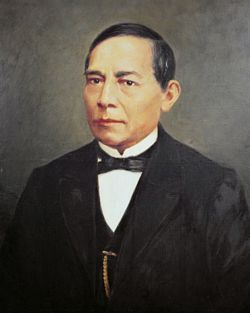 Before I delve deeper into each of the different busts, let us first start by talking about the individual who is on that coinage. That person is Benito Juárez who lived from 1806 to1872. He was born in Oaxaca to poor, indigenous farmers and was orphaned at a young age. He eventually moved to Oaxaca City where he was aided by a Franciscan who helped him continue with his education, whereupon he later enrolled in the seminary. Growing up he had an interest and passion in liberal politics and eventually enrolled in the Institute of Sciences and Arts where he studied law. Upon graduation, he served in multiple capacities as a lawyer, prosecutor, civil judge, state legislator, governor and later as the President of the Mexico Supreme Court of Justice. It was this last position that helped elevate him to assume the presidency upon the resignation of President Ignacio Comonfort. Upon this resignation, Juárez became the 26th President of Mexico and held that position from 1858 to1872. He also has the distinction of being the first president of Mexico of indigenous origin, of Zapotec ethnicity. He was generally held in high regard and was seen as a man of the people and worked throughout his presidency trying to improve the lives of indigenous Mexicans. On a historical side note, Juárez was also the individual who authorized the execution by firing squad of Emperor Maximilian who occupied part of the country during the French Intervention (1862-1867).
Before I delve deeper into each of the different busts, let us first start by talking about the individual who is on that coinage. That person is Benito Juárez who lived from 1806 to1872. He was born in Oaxaca to poor, indigenous farmers and was orphaned at a young age. He eventually moved to Oaxaca City where he was aided by a Franciscan who helped him continue with his education, whereupon he later enrolled in the seminary. Growing up he had an interest and passion in liberal politics and eventually enrolled in the Institute of Sciences and Arts where he studied law. Upon graduation, he served in multiple capacities as a lawyer, prosecutor, civil judge, state legislator, governor and later as the President of the Mexico Supreme Court of Justice. It was this last position that helped elevate him to assume the presidency upon the resignation of President Ignacio Comonfort. Upon this resignation, Juárez became the 26th President of Mexico and held that position from 1858 to1872. He also has the distinction of being the first president of Mexico of indigenous origin, of Zapotec ethnicity. He was generally held in high regard and was seen as a man of the people and worked throughout his presidency trying to improve the lives of indigenous Mexicans. On a historical side note, Juárez was also the individual who authorized the execution by firing squad of Emperor Maximilian who occupied part of the country during the French Intervention (1862-1867).
Many books and publications have discussed and described the busts on the Oaxaca revolutionary coinage. With that said, there are three that I feel are necessary for any collector of this series since each one has information that is helpful with the identification of the known varieties to include the different busts on the coinage. The first, and most widely used is Mexican Revolutionary Coinage 1913-1917 by Hugh Guthrie and Merrill Bothamley, published in 1976. Next, La Ventana, The Window to the Revolutionary Coinage of Oaxaca 1915 by C “Woody” Woodworth and Joe Flores, published in 1988 (and available in the USMexNA online library), which further differentiated and documented the varieties. Finally, Tricolor Compendium of Mexican Revolutionary Coinage, Volume III (one volume with Oaxaca of a 3-volume set) by Carlos Abel Amaya Guerra, published in 2015 which identified even more varieties.
The following is an excerpt from La Ventana which illustrates the two hubs consisting of the legend hub and the bust hub which was utilized by the Oaxacan mint authorities to create a single obverse die.
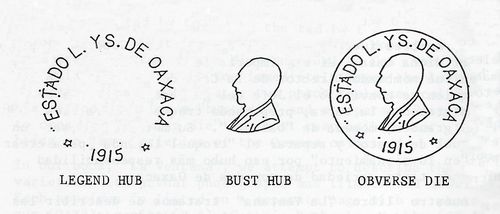
This process was repeatedly used with the ten different bust designs on the various denominations being struck. It is also worth mentioning that the bust hub was never placed in the exact same position on the dies when creating the different dies, therefore some of the busts are frequently offcenter and even slightly slanted. The bust also has the appearance of being small or large depending on the size of the planchet, but the bust is essentially the same size when compared coin to coin.
For example, the bust on 5 centavos will appear large since it takes up a larger portion of the coin surface area compared to a 2 pesos where the bust appears much smaller since there is much more open field surface on the coin. See images below for comparison. On each, the bust size is about the same if not the exact same since most of the bust hubs were reused and often reworked to fit the needs of the specific denomination being struck.

5 Centavos 10 Centavos 20 Centavos 20 Centavos 2 Pesos
22mm 26mm 31mm (large) 28mm (small) 34mm
Example of Bust #6 on five different specimens.
It is also worth mentioning that the mint also made numerous adjustments with the legend which provided even more obverse and reverse varieties. Most of these final changes on the completed die were painstakingly made by hand usually under less-than-ideal conditions. This is evident in the number of re-engraved letters, periods, stars, borders as well as a myriad of die marks and dies scratches than can be seen on the coins. Some dies can also be seen in different states of deterioration, as well as some which have strong die clashes which occurred during the striking process which made for even more interesting varieties on top of an existing variety.
The following is an excerpt from the Tricolor Compendium of Mexican Coinage, Vol. III. It is the single best pictorial reference on the various bust designs of Oaxaca which also includes a reference to the Krause (KM) bust numbers used by the third-party grading agencies for grading and attribution.
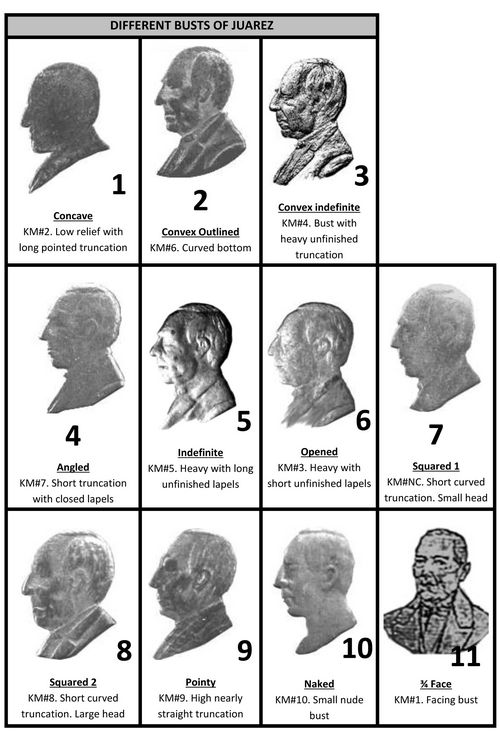
The following is a detailed review of the ten known busts, as well as images of the various denominations which were struck using the specific listed bust variety. AII images are enlarged to a consistent size to show design detail on all denominations, as well as highlight bust positioning.
The following are images of Bust #1 (KM #1, Amaya #11) which is the only bust with a “facing” design, as opposed to a profile view as evident on all other bust designs. Along with the ¾ facing design, it is also the only variety where the overall bust design is incuse. This bust design was only used on a single 5 centavos variety. It is also one that most collectors will most likely never see in person due to its extreme rarity. It is widely believed this bust design was a pattern that was rejected and abandoned by the mint, most likely due to the complexity of the die.
 |
 |
 |
||
| Krause Bust #1 Amaya Bust #11 (enlarged) |
5 Centavos GB-300 lmage from Guthrie-Bothamley. |
5 Centavos A-OX-19 lmage from Carlos Amaya. |
The following are images of Bust #2 (KM #2, Amaya #1) which is the only bust with a profile that is fl at or extremely low relief in design. AII other profile bust varieties have more design characteristics than what is seen on Bust #2. This bust also has a concave bottom. It is important to note that this variety comes with several features where parts of the design have sharp or rounded points at the end of the base of the bust. This bust can be seen on four different denominations (1c, 5c, 10c, 20c).
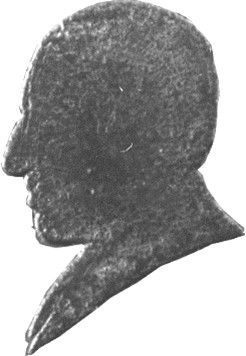 |
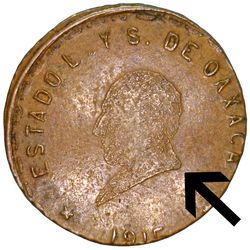 |
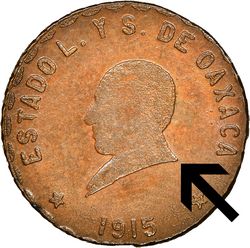 |
||
| Krause Bust #2 Amaya Bust#1 (enlarged) |
1 Centavo LV-5, GB-292, A-OX-3 Rounded right point at the base. |
1 Centavo LV-6, GB-293, A-OX-5 Sharp right point at the base. |
||
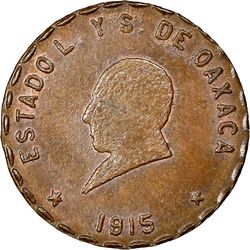 |
 |
 |
||
| 5 Centavos LV-18, GB-UNL, A-OX-25 |
10 Centavos LV-30, GB-318, A-OX-44 |
10 Centavos LV-34, GB-317, A-OX-50 |
The following are images of Bust #3 (KM #3, Amaya #6). This bust is one that is easily confused with other busts of Juárez, especially Bust #4 and Bust #5. Bust #3 is relatively easy to identify if you look at the bottom left of bust where it is easy to see that the lapel detail is short and somewhat incomplete. Essentially, it fades and gives the appearance that it is unfinished, while Bust #4 and Bust #5 show more detail. Note that the date on the gold 5 pesos is located right over the base of the bust. Bust #3 can be seen on eight different denominations (5c, 10c, 20c 50c, $1, $5(Gold), $10(Gold), $20(Gold)).
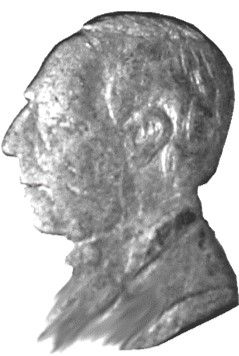 |
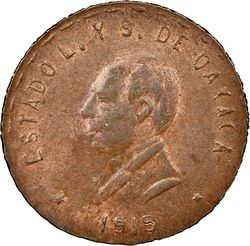 |
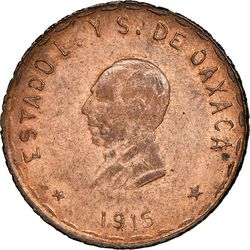 |
||
| Krause Bust #3 Amaya Bust #6 (enlarged) |
5 Centavos LV-26, GB-305, A-OX-39 |
10 Centavos LV-45, GB-311, A-OX-76 |
||
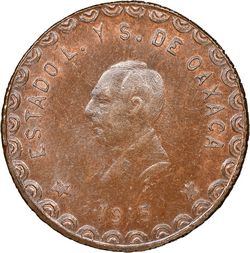 |
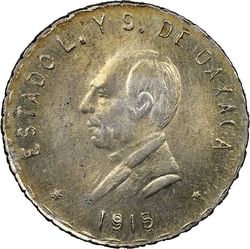 |
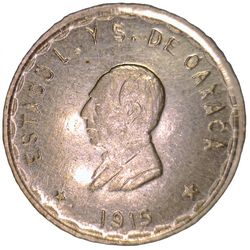 |
||
| 20 Centavos LV-70, GB-333, A-OX-99 |
50 Centavos LV-81, GB-338, A-OX-112 |
1 Peso LV-90, GB-343, A-OX-123 |
||
 |
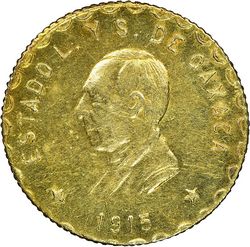 |
 |
||
| 5 Pesos (Gold) LV-123, GB-372, A-OX-170 |
10 Pesos (Gold) LV-125, GB-375, A-OX-173 |
20 Pesos (Gold) LV-126, GB-376, A-OX-174 |
The following are images of Bust #4 (KM #4, Amaya #3). This bust is one that is easily confused with previously mentioned Bust #3. The Oaxaca Mint appears to have reworked Bust #3 to bring out more details in the lapels on the bottom and top left. It does not fade away quickly like what is seen in Bust #3. The top of the lapel is also slightly more rounded in appearance compared to Bust #3 and Bust #5. This bust can be seen on five different denominations (10c, 20c, $1, $2, $20(Gold)).
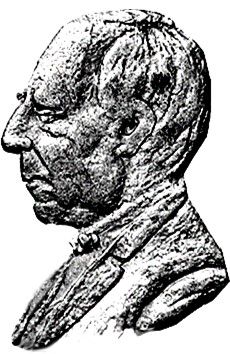 |
 |
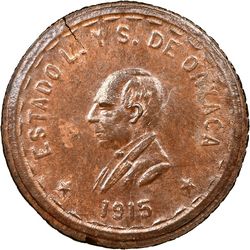 |
||
| Krause Bust #4 Amaya Bust #3 (enlarged) |
10 Centavos LV-52.5, GB-315, A-OX-74 |
20 Centavos LV-68, GB-327, A-OX-97 |
||
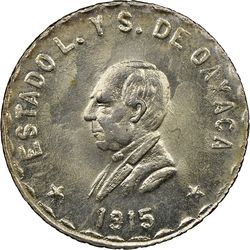 |
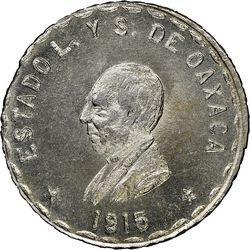 |
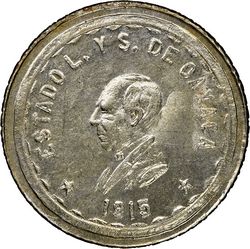 |
||
| 1 Peso LV-93.5, GB-346, A-OX-126 |
1 Peso LV-96, GB-345, A-OX-131 |
2 Pesos LV-113, GB-357, A-OX-153 |
The following are images of Bust #5 (KM #5, Amaya #5). The design has long unfinished lapels and is often confused with previously mentioned Bust #3 and Bust #4. Carlos Amaya describes this bust as “heavy with long unfinished lapels” which shows a left lapel that is a bit longer and better defined than Bust #3 and Bust #4. The top of the lapel is also not as rounded in design as what is seen on Bust #4. Once you better understand the design attributes as well as view the designs side by side, it is much easier to differentiate the three busts in question. This bust can be seen on four different denominations (5c, 50c, $2, $10(Gold)).
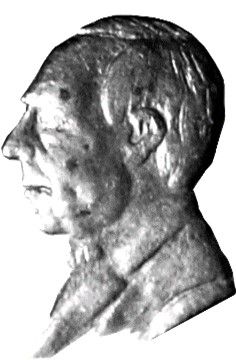 |
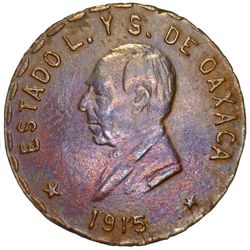 |
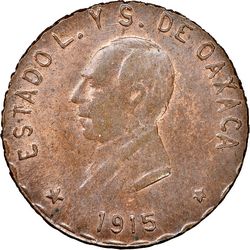 |
||
| Krause Bust #5 Amaya Bust #5 (enlarged) |
5 Centavos LV-23, GB-303, A-OX-34 |
5 Centavos LV-24, GB-UNL, A-OX-36 |
||
 |
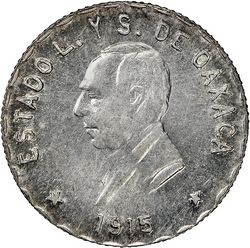 |
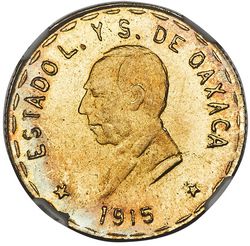 |
||
| 50 Centavos LV-75, GB-UNL, A-OX-108 |
2 Pesos LV-117, GB-352, A-OX-160 |
10 Pesos (Gold) LV-124, GB-374, A-OX-171 |
The following are images of Bust #6 (KM #6, Amaya #2). This variety is very easy to identify as the bottom portion of the bust is well defined and curved which is quite a stark contrast compared to the bust designs on Bust #3, Bust #4 and Bust #5 which are incomplete and have an inconsistent bust base. This bust was also extremely popular and can be seen on seven different denominations (5c, 10c, 20c, 50c, $1, $2, $5(Silver)).
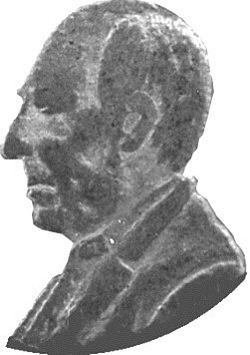 |
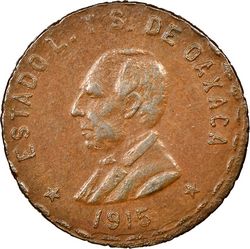 |
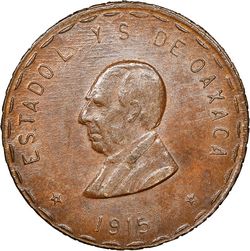 |
||
| Krause Bust #6 Amaya Bust #2 (enlarged) |
5 Centavos LV-20, GB-307, A-OX-27 |
10 Centavos LV-36, GB-UNL, A-OX-53 |
||
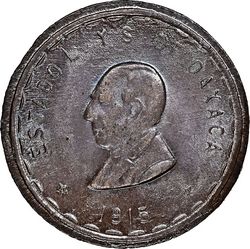 |
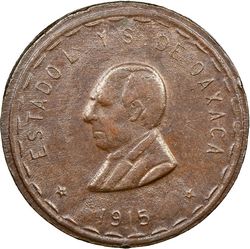 |
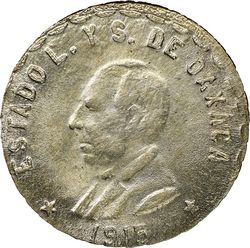 |
||
| 20 Centavos LV-60, GB-328, A-OX-86 |
20 Centavos LV-61, GB-329, A-OX-87 |
50 Centavos LV-77, GB-339, A-OX-106 |
||
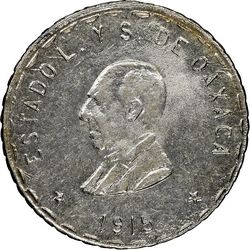 |
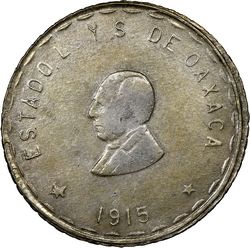 |
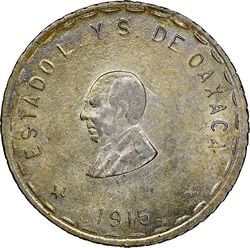 |
||
| 1 Peso LV-86, GB-UNL, A-OX-118 |
2 Pesos LV-108, GB-UNL, A-OX-146 |
2 Pesos LV-109, GB-UNL, A-OX-147 |
The following are images of Bust #7 (KM #7, Amaya #4). This bust is easily identified since the bottom is well defined and angled and not rounded) like Bust # 6 . Amaya describes this bust as having a “short truncation with closed lapels”. Note that every variety of 3 centavos, except one that has a different bust, has the date located right over the base of the bust, as opposed to an area right below the base of the bust as on the other denominations. Bust #7 is also one of the most popular busts used on the coinage as it can be seen on nine different denominations (3c, 5c, 10c, 20c, 50c, $1, $2, $5(Silver), $20(Gold)).
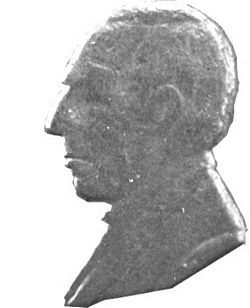 |
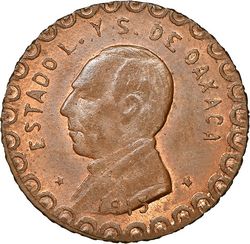 |
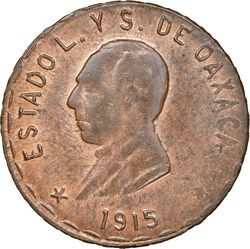 |
||
| Krause Bust #7 Amaya Bust #4 (enlarged) |
3 Centavos LV-13, GB-299, A-OX-17 |
5 Centavos LV-22a, GB-UNL, A-OX-32 |
||
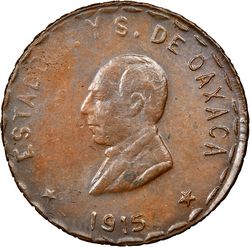 |
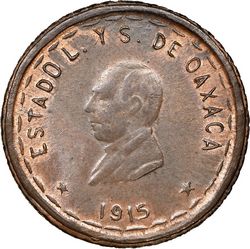 |
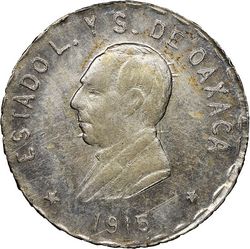 |
||
| 10 Centavos LV-41, GB-UNL, A-OX-62 |
20 Centavos LV-66a, GB-UNL, A-OX-95 |
50 Centavos LV-74, GB-337, A-OX-103 |
||
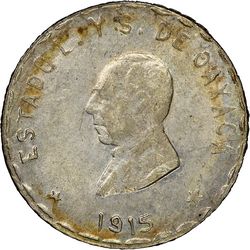 |
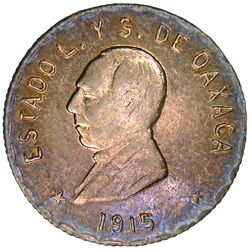 |
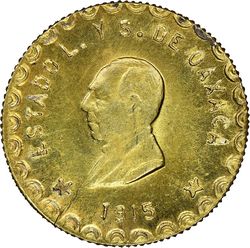 |
||
| 1 Peso LV-88, GB-344, A-OX-121 |
2 Pesos LV-115, GB-351, A-OX-157 |
20 Pesos LV-127, GB-377, A-OX-175 |
The following are images of Bust #8 (KM #NC, Amaya #7 small head and KM #8, Amaya #8 large head). Carlos Amaya documents two busts with differing size for this variety. Since they are essentially the same design, I will simply classify them as Bust #8. This bust is easily identified since it has a slightly curved, well-defined truncation. In fact, it is the only bust variety with a short, slightly curved truncation of the lapels. This rarely used bust design is only seen on three denominations (5c, 10c, 50c). Not much is known on the 10c variety (Amaya #7 small head): however it is most likely a pattern.
 |
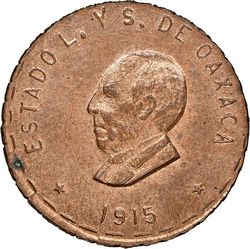 |
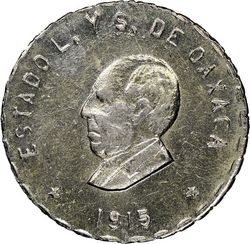 |
||
| Krause Bust #8 Amaya Bust#7 (Squared 1) & Bust #8 (Squared 2) (enlarged) |
5 Centavos LV-27, GB-306, A-OX-40 |
50 Centavos LV-82, GB-340, A-OX-114 |
The following are images of Bust #9 (KM #9, Amaya #9). This design is considered by many to be a rare pattern as it is only seen on the 50 centavos. It is easily identifiable since it has an almost straight base and a short, narrow pointed lapel. The images below are copies of the pictures from Carlos Amaya and Guthrie-Bothamley since higher resolution images were not available.
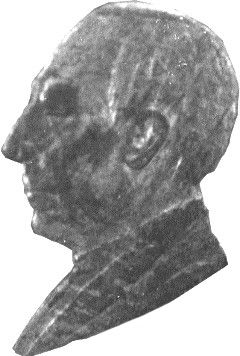 |
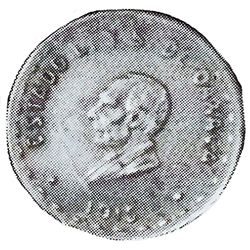 |
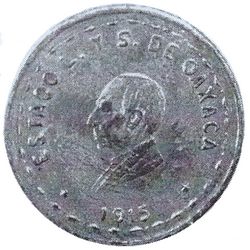 |
||
| Krause Bust #9 Amaya Bust #9 (enlarged) |
50 Centavos LV-71 Image from La Ventana. |
50 Centavos A-OX-101 Image from Carlos Amaya. |
The following are images of Bust #10 (KM #10, Amaya #10). This design is seen on only two denominations ($2, $60(Gold)). The 2 pesos variety is considered extremely rare and may have been a pattern. Also, it can be seen on what many believe to be the most beautiful issue from Oaxaca which is the 60 pesos struck in gold, silver and copper. Although some believe that the copper strikes are patterns, many others believe that the copper and silver strikes were struck after the revolution using the original dies. For this article, I am not making any assertions regarding the history of those coins but would simply like to focus on the bust design for that particular denomination.
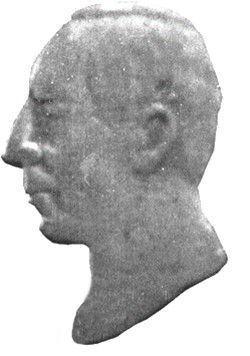 |
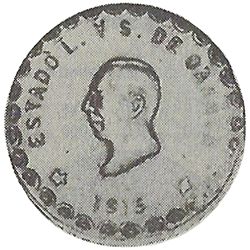 |
 |
||
| Krause Bust #10 Amaya Bust#10 (enlarged) |
2 Pesos A-OX-152 lmage from Carlos Amaya. |
60 Pesos LV-130, GB-379, A-OX-178 lmage from Heritage Auctions. |
The following table is a detailed cross reference between the three major documented sources on the various Oaxaca obverse denominations, busts, and varieties - Guthrie Bothamley (GB), La Ventana (LV) and Carlos Abel Amaya Guerra (A-OX ). Only the varieties which have a bust of Benito Juárez are documented within. I have attempted to document most of the known varieties using these references. However, some were excluded due to space constraints: therefore I strived to only include most of the major known varieties.
| Denomination | Bust | LV | GB | A-OX |
| 1c | 2 | 5 | 292 | 3 |
| 6 | 293 | 5 | ||
| 7 | 294 | |||
| 8 | 295 | 7 | ||
| 3c | 7 | 9 | 296 | 11 |
| 10 | 12 | |||
| 11 | 297 | 13 | ||
| 12 | 298 | 15 | ||
| 13 | 299 | 17 | ||
| 5c | 1 | 15 | 300 | 19 |
| 2 | 16 | 308 | 20 | |
| 17 | 309 | 22 | ||
| 18 | 25 | |||
| 19 | 26 | |||
| 6 | 20 | 307 | 27 | |
| 21 | 28 | |||
| 7 | 22 | 302 | 30 | |
| 22a | 32 | |||
| 5 | 23 | 303 | 34 | |
| 24 | 36 | |||
| 25 | 304 | 37 | ||
| 3 | 26 | 305 | 39 | |
| 8 | 27 | 306 | 40 | |
| 10c | 2 | 28 | 323 | 42 |
| 29 | 43 | |||
| 30 | 318 | 44 | ||
| 31 | 47 | |||
| 32 | 319 | 48 | ||
| 33 | 49 | |||
| 34 | 317 | 50 | ||
| 6 | 35 | 316 | 51 | |
| 52 | ||||
| 36 | 53 | |||
| 37 | 313 | 54 | ||
| 38 | 55 | |||
| 7 | 39 | 59 | ||
| 40 | 60 | |||
| 41 | 62 | |||
| 42 | 61 | |||
| 43 | 310 | 63 | ||
| 43a | 65 | |||
| 64 | ||||
| 44 | 322 | 68 | ||
| 3 | 45 | 311 | 76 | |
| 7 | 46 | 66 | ||
| 47 | 69 | |||
| 70 | ||||
| 48 | 72 | |||
| 6 | 49 | 312 | 56 | |
| 57 | ||||
| 4 | 50 | 314 | 73 | |
| 50a | ||||
| 6 | 51 | 58 | ||
| 4 | 52 | 315 | 74 | |
| 52.5 | ||||
| 53 | 75 | |||
| 7 | 54 | 320 | 77 | |
| 20c | 8 | 78 | ||
| 2 | 55 | 335 | 79 | |
| 6 | 56 | 334 | 80 | |
| 81 | ||||
| 57 | 82 | |||
| 58 | 83 | |||
| 59 | 330 | 84 | ||
| 60 | 328 | 86 | ||
| 61 | 329 | 87 | ||
| 62 | 85 | |||
| 7 | 63 | 325 | 89 | |
| 64 | 90 | |||
| 65 | 91 | |||
| 326 | 92 | |||
| 66 | 324 | 93 | ||
| 66a | 95 | |||
| 4 | 67 | 96 | ||
| 68 | 327 | 97 | ||
| 69 | 331 | 98c | ||
| 6 | 332 | 98b | ||
| 3 | 70 | 333 | 99 | |
| 50c | 9 | 71 | 100 | |
| 72 | 342 | 101 | ||
| 73 | 102 | |||
| 7 | 74 | 337 | 103 | |
| 5 | 75 | 108 | ||
| 6 | 76 | 341 | 107 | |
| 77 | 339 | 106 | ||
| 7 | 78 | 109b | ||
| 5 | 79 | 109 | ||
| 80 | 336 | 110 | ||
| 3 | 81 | 338 | 112 | |
| 8 | 82 | 340 | 114 | |
| 7 | 83 | 341 | 105 | |
| $1 | 6 |
84 | 350 | 116 |
| 85 | 347 | 115 | ||
| 86 | 118 | |||
| 87 | 119 | |||
| 120 | ||||
| 7 | 88 | 344 | 121 | |
| 3 | 89 | 122 | ||
| 90 | 343 | 123 | ||
| 4 | 91 | 125 | ||
| 92 | 124 | |||
| 93 | 346 | 126 | ||
| 93.5 | ||||
| 94 | 349 | 127 | ||
| 95 | 350 | 129 | ||
| 95.5 | 130 | |||
| 96 | 345 | 131 | ||
| 96.5 | ||||
| 132 | ||||
| 97 | 134 | |||
| 98 | 133 | |||
| $2 | 6 | 99 | 135 | |
| 100 | 363 | 136 | ||
| 101 | 138 | |||
| 102 | 366 | 139 | ||
| 103 | 140 | |||
| 104 | 364 | 142 | ||
| 105 | 143 | |||
| 106 | 365 | 144 | ||
| 107 | 367 | 145 | ||
| 107.5 | 145b | |||
| 108 | 146 | |||
| 109 | 147 | |||
| 110 | 361 | 149 | ||
| 111 | 362 | 150 | ||
| 10 | 112 | 360 | 152 | |
| 4 | 113 | 357 | 153 | |
| 114 | 356 | 156 | ||
| 7 | 115 | 351 | 157 | |
| 116 | 353 | 158 | ||
| 354 | 159 | |||
| 5 | 117 | 352 | 160 | |
| 118 | 161 | |||
| $5 (Silver) | 7 | 119 | 163 | |
| 120 | 368 | 165 | ||
| $5 (Copper) | 121 | 371 | 169 | |
| $5 (Silver) | 6 | 122 | 370 | |
| $5 (Gold) | 3 | 123 | 372 | 170 |
| $10 (Gold) | 5 | 124 | 374 | 171 |
| 3 | 125 | 375 | 173 | |
| $20 (Gold) | 3 | 126 | 376 | 174 |
| 7 | 127 | 377 | 175 | |
| 128 | 176 | |||
| 4 | 129 | 378 | 177 | |
| $60 (Gold) | 10 | 130 | 379 | 178 |
| $60 (Copper) | 131 | 381 | 198 | |
| $60 (Silver) | 132 | 380 | 198b |
Summary
This completes my effort to examine and document the ten known bust designs. This has been not only a labor of love for me, but one that I feel is needed for the collector of this series. For years I struggled trying to determine all the different bust types on the various Oaxacan issues. Although most of the information presented was readily available from the previous mentioned publications, many collectors may not own any of the three references which would make collecting the coins in this series difficult. Using these references, positioned me well to consolidate and present the information within this article. It is my sincerest hope that the cross reference chart will be especially helpful when seeking out the varieties to include the appropriate bust on that particular variety. This might also be useful when submitting any Oaxaca revolutionary coinage to the third-party grading companies since they have not been the most accurate with their bust attributions. Even if you do not submit to a third-party grading service, at least you now have the information to help attribute the bust on the coins in your collection which should then help you further identify the particular variety.
Finally, I would like to give appreciation to all my fellow Mexico Revolutionary collectors and dealers who have helped me not only grow my collection over the years, but also provided me with information to help me go forth and conquer the revolutionary coinage world with confidence. I would like to extend a special thanks to Carlos Amaya for allowing me to use the information provided within and for the opportunity to collaborate with him on his Tricolor Compendium set. I would also like to acknowledge Joe Flores and all his contributions with the Oaxaca series and revolutionary coinage in general. Although Joe passed in 2021, I still fondly recall many great conversations with him over the years especially at the annual USMexNA Convention in Scottsdale. He was a true gentleman, and he was always willing to share his knowledge. Lastly, an acknowledgement of Ricardo Medina, Sr. who was the first dealer who encouraged me to expand my horizons by collecting Mexican Revolutionary coinage. Mr. Medina passed away in 2015, but there is not a time I do not think of him when I find a rare or interesting revolutionary coin that I am adding to my collection.
Please send your comments, questions or suggestions regarding this article, to me at
While it may appear to most collectors that this series have been “over catalogued”, since we even have a specialized book dealing with it, La Ventana by Woodworth and Flores{footnote}C. ‘Woody’ Woodworth and Joe Flores, La Ventana. Oaxaca Edition. Privately Printed 1988, available in the USMexNA online library {/footnote}, as well as a very recent approach to list all the known dies and their combinations{footnote}Carlos Abel Amaya Guerra, Compendio Tricolor de la Moneda de la Revolución Mexicana. Volumen III. Privately printed. Monterrey, Nuevo León, México, 2015){/footnote}, it is always exciting to learn about new varieties that have remained undetected or at least unreported. Such is the case of the Oaxaca “Dos Pesos” 1915 coin reported herein.
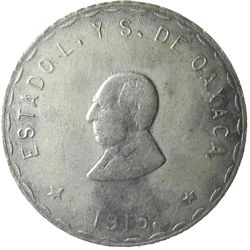
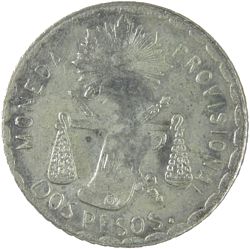
The coin in question was part of a very old collection that I recently acquired and, while checking new purchases against my own collection for upgrades, I noticed that the reverse (balance scale side) is unlisted in all major references dealing with the series. This triggered an inquiry with a group of friends and numismatists and I was pleased to learn of three more examples of this new variety; thus, there is a good chance that this coin is to be found with some effort since it may not be particularly rare.
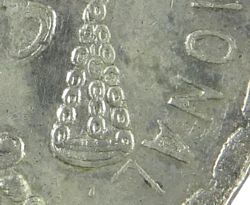

On this new specimen, the obverse die is well known in major catalogs; it was assigned die number “H” by Verne R. Walrafen{footnote}Verne R. Walrafen, The Mexican Revolution Reporter, Issue Number Twelve, February 1979, The Revolutionary Mexican Historical Society{/footnote} and is listed as Obverse 45 in Amaya’s compendium. The key difference is a totally new reverse die that is easily identifiable by looking at the right balance scale plate which is situated very close to, but higher than the “L” on the legend. Also the “PE” of Pesos is dramatically tilted to the left in contrast to the rest of the legend. Several other minor differences will be found such as the location of the “D” in reference to the balance scale plate as well as what appears to be double hubbing on “PROVISIONAL”. This specimen weighs 14.4 grams, has a diameter of 33 mm, and a corded edge.
(based on Angel Smith Herrera , The Oaxaca 1915 Dos Pesos Series, A New Addition. USMexNA journal, September 2015)
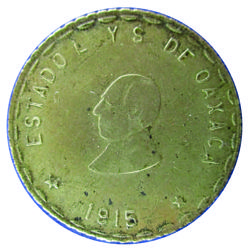
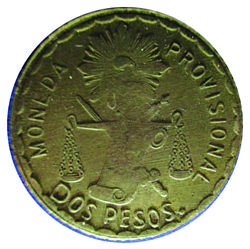
I have been aware for a number of years that two of the Oaxaca Dos Pesos coins in my collection were probably undescribed and not listed in La Ventana. Recently I was informed that one of them had been described by Angel Herrera in the Sept 2015 issue of the USMexNA journal. This encouraged me to see if the other coin was also undescribed. Pictures were sent to Angel and he agrees that this is the case, so I am now presenting this coin. It has the reverse of LV 106 and LV 107 but an undescribed obverse. This obverse is pictured along with the reverse and a blowup of the signature S in PESOS.
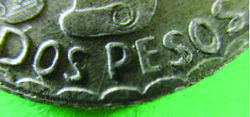
The reverse has the signature S in PESOS and also has the same striations between the scroll and the right half of the scale as LV 106 and LV 107. The obverse has a complete O in ESTADO so this coin is not LV 106. The obverse also does not have the comma after OAXACA or the period after the date (1915), so this is also not LV 107. This die combination is not listed in La Ventana{footnote}C “Woody” Woodworth and Joe Flores, op. cit.{/footnote}.
(based on Terence Stoddard, A new Die Combination of an Estado de Oaxaca Dos Pesos, USMexNA journal, December 2022)
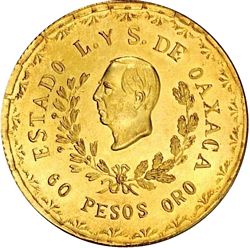
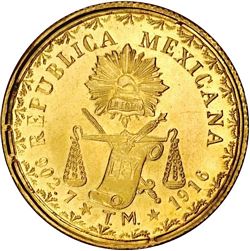
KM-755, GB-379, A-OX-178 $60 gold (Stack’s-Bowers, The Louis E. Eliasberg, Sr. Collection, 15 April 2005, lot 3424)
In his memoirs Pablo Neuman recorded{footnote}Boletín Numismatico,{/footnote}
To fulfil my promise to the Governor, I arrived in Oaxaca the following Saturday and on Sunday sent to let him know I was at his disposition. An appointment was fixed for Monday at nine o'clock when I was received and when I gave him examples of my tokens. The Governor was interested in the manufacture of the pieces and finally told me that "if we have machinery the State Government could provide enough coin for your needs".
"Sir, the only thing that you need is the metal, as the machinery is some where in the city and has been since the end of the last century”
"I would like to see this machinery."
"If you wish Governor. I'll take you right now.”
We then went to a colonial style house in front of the Cathedral where in 1910 were the Stamp offices, the mining agency, and the Federal Offices. In that year the State Government had charged me to find machinery for a Mint. Everything was very broken down but it could be made to work.
The Governor wanted me to take charge of the Mint, but I could not because of my job in San Miguel Peras. I offered to help and to cooperate to the best of my ability and I recommended the following people who were able to undertake the work - Simon Ferguson, John de Coe, José Massa. Paul Ehrlich and August Hamenstein of whom the first three took a most active part in the setting up and later in the actual coinage.
Mr. John De Coe busied himself in engraving the first dies. He used for the reverse of some of the coins, particularly those of "Dos Pesos" some dies which had been used for the coinage of the last century. Mr. Teofilo Monroy was made Director of the resurrected Mint, and a Mr. Bellon who with his brothers had a commercial establishment - "Bellon Hnos." - also took part. They sold old gold pieces for conversion to the new issue.
I only sold gold dust from the mountains of the State, and that too in small quantities for very seldom was more than a kilogramme sent. For the striking of the famous 60 peso pieces I handed over an ingot of no more than 1,200 grammes to Governor Davila of about .859 fineness. The usual natural fineness in San Miguel Peras was about 820 and only on two occasions Wenceslao Garcia had the luck by means of a mercury amalgam to get 960 and 940.
Opinions vary about the number of 60 peso pieces actually coined. It is, however, quite certain that the number is very limited in that the amount of gold I sold was very small and that striking only started on the eve of the collapse of the government of the Sovereign State whose flight was a hurried one. Defective pieces began to come out and I have only seen seven examples of which two were given to the Governor, two to the Military Commander in Chief Guillermo Meixueiro, one to the Bustamante family. one to a teacher of English Mr. Eusebio P. León, and the other to Mr. Manuel García Vigil who was a nephew of Wenceslao Garcia, and who later became Governor of Oaxaca. Even though one triplicates or even quintuplicates the number seven it is easy to see that the gold 60 peso piece is evidently much rare than is generally believed.”
Teofilo Monroy’s son, Miguel, adds{footnote}{/footnote}
"The dies for the sixty peso gold Oaxaca coin were personally cut by Mr. Teófilo Monroy, on the night preceding the evacuation of the city of Oaxaca by the troops of the Sovereign Government of that State. He only struck forty or forty-five coins. All the specimens were confiscated by members of the Carrancista army, who on showing them: off were heard saying that they were only gilt coins whose circulation the Sovereign Government wanted to force with a nominal value of sixty pesos”.
''Ingeniero Howard L. Elton technically helped in the design of all the Oaxaca coins and very particularly in the arrangement of the sixty peso pieces. This gentleman was executed by the Carranza troops. On the other band, Ingeniero Pablo Neumann was the one who sold the gold required for the sixty peso specimens. By the way it is interesting to note that all efforts were made to design this piece with the same diameter and thickness of the old "pesos fuertes" (large dollars) and that the fineness of the metal used was the same shown on those old pesos, that is 902.7".
[ ]{footnote}{/footnote} argues that four main types of the 60 Pesos can exist.
l. Original strikings.
2. Restrikes from the original dies, which were in the possession of Miguel Monroy in 1932{footnote}J. Sanchez Garza, {/footnote} and acquired by the ANS in 1951.
3. Cast copies of the original coin or restrike. These are lacking in three respects: (1) they have a granulated surface; (2) there is an absence of any true stress marks; and (3) the faulty duplication of the milled or reeded edge, which is is all perfect and at right angles to the planchet. and
4. Counterfeits made from newly prepared dies. The lettering differs from the original in shape and size. Also in depth of cutting. The ornaments around the edge does not follow the original design. The period after the T in T.M. is too far from the T.
Flores{footnote}C. "Woody" Woodworth and Joe Flores, La Ventana, privately printed, 1988{/footnote} states that the obverse die has several identifying marks. The top left of the "E" in DE and the bottom of the "C" in OAXACA are re-engraved and most collectors also look for three small vertical scratches on Juárez' face in the area of the cheek-bone. The reverse shows the "P" and "U" of REPUBLICA and the "9" of 902.7 re-engraved.
This article will focus on the counterfeit for one of the more controversial, as well as interesting coins from this era, that coin being the State of Oaxaca rectangular three centavos with the “PROVISIO” legend. Commonly catalogued as Guthrie-Bothamley GB-290 or Woodworth-Flores (La Ventana) LV-3.
Many coins which I plan to review will be easy to spot the fake when compared to the genuine specimen while others will be quite difficult due to the better quality and craftsmanship of the fake. In this case, I will be presenting two different, yet similar fake coins which I feel are relatively well-made and may be difficult for the novice collector to identify as a counterfeit but on the other hand, they should be relatively easy for an experienced collector to identify. In my opinion, the counterfeit of this variety is well made and should be considered a somewhat dangerous fake.
Genuine Copper 3 Centavos (1915)
Plain Edge, 6.94 g, 16.23 mm (H) x 24.06 mm (W)
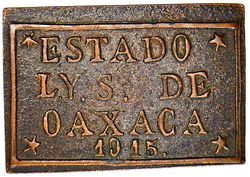
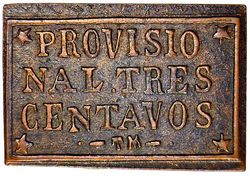
Counterfeit Example #1
Plain Edge, 2.52 g, 16.59 mm (H) x 24.29 mm (W)
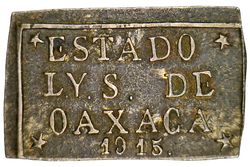

Counterfeit Example #2
Plain Edge, 3.23 g, 15.41 mm (H) x 24.52 mm (W)
Let me start by stating that I believe this counterfeit to be a modern fabrication and not something contemporary from the revolutionary period. Although it is possible it could be a contemporary strike, I strongly feel that it is of modern origin primarily because these have only been observed in the market in more recent times. Also, the original strikes were so unpopular at the time of the revolution, it was reported that most were melted, hence there was probably a single pair of dies. Lastly, all genuine examples I have seen over the years were all struck from the same pair of dies.
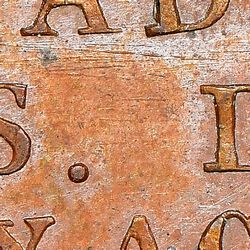
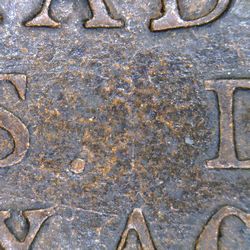
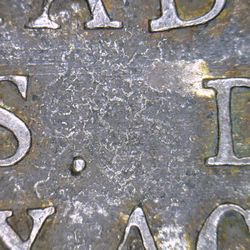
Genuine Counterfeit #1 Counterfeit #2
The first attribute I would like to highlight between the three coins is their size or dimension. All three are very close in height and width, however the weight is quite a bit different. Although weights and sizes do vary between coins, especially with coins from the Mexican Revolution, the genuine example mentioned here is approximately seven grams while both fakes are less than half that weight (2.52 g and 3.23 g respectively). Essentially, the planchets on the fakes are much thinner than the genuine coin. Another key point to highlight between the genuine and the fakes is the fact that the coin surface on the open fields of the genuine coin is moderately smooth and flat in appearance with the occasional die marks which look like long, thin lines while fakes have an uneven, rough appearance and do not show any signs of die marks like what is seen on the genuine coin. The surface on the fakes looks like what might best be described as leathery and uneven in appearance.
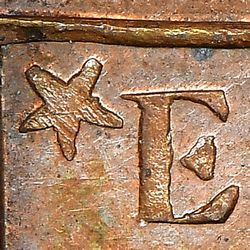
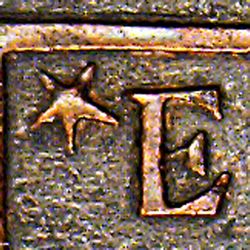
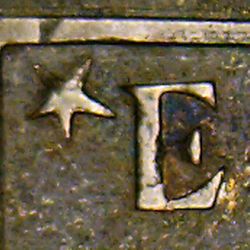
Genuine Counterfeit #1 Counterfeit #2
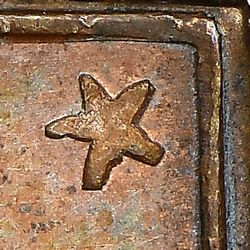
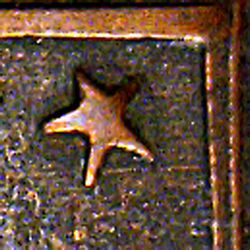
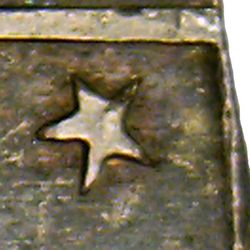
Genuine Counterfeit #1 Counterfeit #2
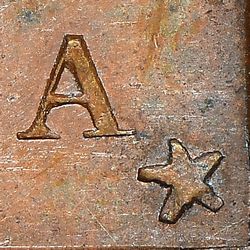
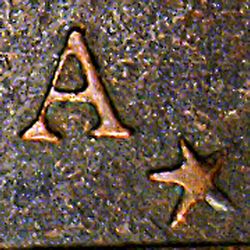
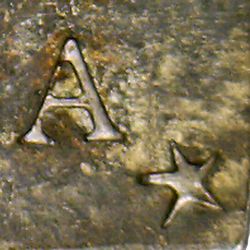
Genuine Counterfeit #1 Counterfeit #2
If you look closely at the three “star” pictures from the obverse, you will easily see that the genuine stars are much more uniform in shape and style, while the stars on both counterfeit examples are inconsistent in shape to include several points which are smaller or narrower than the other points.
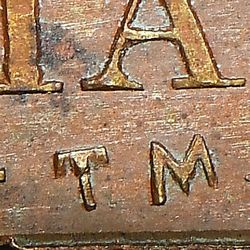

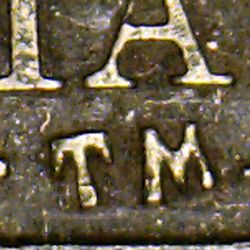
Genuine Counterfeit #1 Counterfeit #2
The easiest identifier on the reverse is the slightly angled letters “TM” located at the lower center area. The genuine letters have thin and simple lines while the right leg of the “M” is marginally shorter than the corresponding left side of the letter. In comparison, in both fakes, the letters are close together, as well as thick and bold, while the right leg of the “M” is long and relatively close to the same length as the corresponding left leg of the same letter.
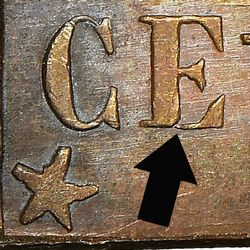

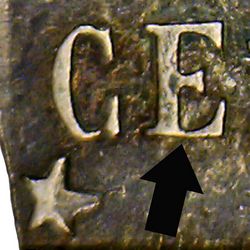
Genuine Counterfeit #1 Counterfeit #2
Just like the stars on the obverse, the stars on the reverse are one of the easiest ways to identify a genuine coin from a counterfeit. As previously stated, the stars on the genuine coin are very uniform in appearance while the fakes are more inconsistent in shape and size. Also, the letter “E” in “CENTAVOS” has a slight, narrow, open gap on the base leg where it meets up with the vertical bar of the letter, while both fakes are clearly connected but does show a very small notch, but not a full gap like the genuine strike.
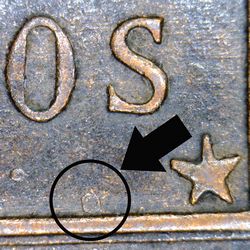
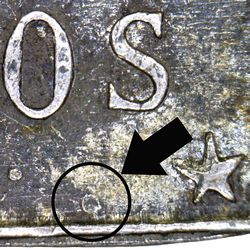
Counterfeit #1 Counterfeit #2
Finally, there is a large dot located between the right period or small dot after the letters “TM” positioned just to the left of the bottom right star just above the lined border which surrounds the coin. This appears to be some sort of die mark or punch mark which was most likely unintentional since this large dot is not something seen as an attribute on the genuine coin. This also leads to the conclusion that both fakes presented here most likely came from the same die pair. They were probably struck at different times since they both have slight variations with some of the attributes due to probably retooling and/or simply from wear from the striking of the coins. Based on the coin details, counterfeit #1 is probably an early strike since the details are much clearer and more concise while counterfeit #2 looks more like a late strike as the attributes are not as sharp and clear with some weakly struck areas when compared to counterfeit #1.
The modern counterfeit of a State of Oaxaca three centavos with the PROVISIO legend reviewed within this article is relatively well made and should be considered a somewhat dangerous counterfeit. Therefore, you should be wary when purchasing this variety unless you understand the key differences since a genuine strike will be quite a bit more expensive and valuable than a counterfeit. Also, I would like to state that there are several other attributes involving the legend lettering not presented here due to space constraints which could help distinguish between a real strike and a counterfeit, therefore do not use what has been reviewed as the complete list of differences but only a sampling of information and what I feel are the easiest and most straightforward to use to evaluate the genuineness of a coin.
Please send your comments, questions, or suggestions regarding this article, to me at